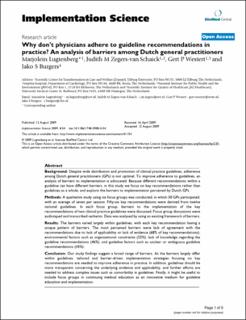| dc.contributor.author | Lugtenberg, M. | |
| dc.contributor.author | Zegers-van Schaick, J. M. | |
| dc.contributor.author | Westert, G. P. | |
| dc.contributor.author | Burgers, J. S. | |
| dc.date.accessioned | 2023-01-06T10:13:32Z | |
| dc.date.available | 2023-01-06T10:13:32Z | |
| dc.date.issued | 2009 | |
| dc.identifier.citation | Lugtenberg, M., Zegers-van Schaick, J. M., Westert, G. P. & Burgers, J. S. (2009). Why don’t physicians adhere to guideline recommendations in practice? An analysis of barriers among Dutch general practitioners. Implementation Science, 4(1), 54. | en_US |
| dc.identifier.uri | https://hdl.handle.net/11250/3041493 | |
| dc.description.abstract | Background
Despite wide distribution and promotion of clinical practice guidelines, adherence among Dutch general practitioners (GPs) is not optimal. To improve adherence to guidelines, an analysis of barriers to implementation is advocated. Because different recommendations within a guideline can have different barriers, in this study we focus on key recommendations rather than guidelines as a whole, and explore the barriers to implementation perceived by Dutch GPs.
Methods
A qualitative study using six focus groups was conducted, in which 30 GPs participated, with an average of seven per session. Fifty-six key recommendations were derived from twelve national guidelines. In each focus group, barriers to the implementation of the key recommendations of two clinical practice guidelines were discussed. Focus group discussions were audiotaped and transcribed verbatim. Data was analysed by using an existing framework of barriers.
Results
The barriers varied largely within guidelines, with each key recommendation having a unique pattern of barriers. The most perceived barriers were lack of agreement with the recommendations due to lack of applicability or lack of evidence (68% of key recommendations), environmental factors such as organisational constraints (52%), lack of knowledge regarding the guideline recommendations (46%), and guideline factors such as unclear or ambiguous guideline recommendations (43%).
Conclusion
Our study findings suggest a broad range of barriers. As the barriers largely differ within guidelines, tailored and barrier-driven implementation strategies focusing on key recommendations are needed to improve adherence in practice. In addition, guidelines should be more transparent concerning the underlying evidence and applicability, and further efforts are needed to address complex issues such as comorbidity in guidelines. Finally, it might be useful to include focus groups in continuing medical education as an innovative medium for guideline education and implementation. | en_US |
| dc.publisher | Implementation Science | en_US |
| dc.rights | Navngivelse 4.0 Internasjonal | * |
| dc.rights.uri | http://creativecommons.org/licenses/by/4.0/deed.no | * |
| dc.subject | focus group | en_US |
| dc.subject | sleep disorder | en_US |
| dc.subject | continue medical education | en_US |
| dc.subject | guideline recommendation | en_US |
| dc.subject | thyroid disorder | en_US |
| dc.subject | implementering | en_US |
| dc.subject | retningslinjer | en_US |
| dc.subject | veiledere | en_US |
| dc.title | Why don’t physicians adhere to guideline recommendations in practice? An analysis of barriers among Dutch general practitioners | en_US |
| dc.type | Journal article | en_US |
| dc.source.pagenumber | 54 | en_US |
| dc.source.volume | 4 | en_US |
| dc.source.journal | Implementation Science | en_US |
| dc.source.issue | 1 | en_US |
| dc.identifier.doi | https://doi.org/10.1186/1748-5908-4-54 | |

